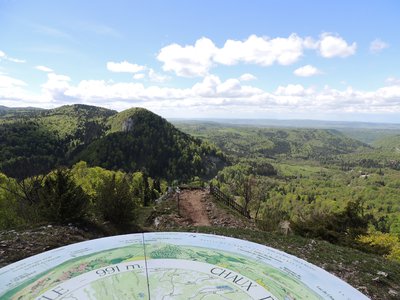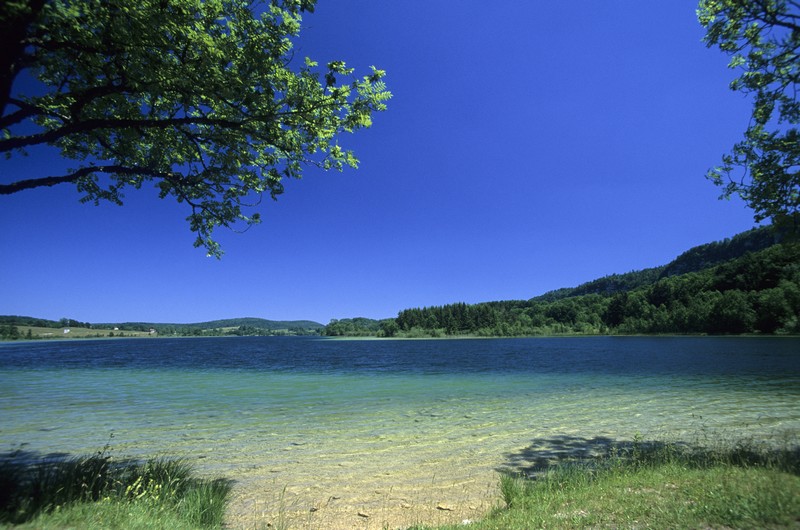
A trip around the three Lakes
These lakes are intriguing, refreshing and calming. Surrounded by remarkable natural and historical heritage, they invite you on a discovery: ponds, reedbeds, marshlands, dry grasslands, etc... A wealth of diversity!
10 points of interest

linaigrettes (CEN Franche-Comté / C.Lapprand) - CEN Franche-Comté / C.Lapprand Natural environmentsThe low marsh
This peculiar peat bog environment can be seen from the path to the Petit Maclu. The few trees and bushes able to grow in these difficult conditions (waterlogged soil, lack of oxygen, etc.) are birches, willows and alder buckthorn. In the spring, the white cotton grass bobbles - a plant typically found in these environments - can be seen above the grass.
The lake used to be bigger. Little by little, aquatic plants have grown, and the permanently humid conditions have not allowed dead vegetation to decompose. By building up, all of these plants have formed what is called peat. In this peat bog, the peat isn’t very thick, but in the peat bog between the Grand Maclu lake and the Ilay lake, it has reached over 1.5m.
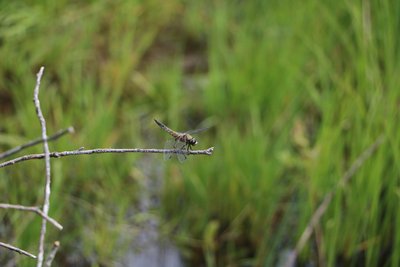
Libellule à quatre taches (CEN Franche-Comté / C.Lapprand) - CEN Franche-Comté / C.Lapprand FaunaDragonflies
These diverse wetlands attract many species of insects, including dragonflies. Over half of the species in mainland France are located around ponds, lakes, rivulets and smaller pools on the site.
The four-spotted chaser is easily recognisable with its very visible dots on the middle of each of its four wings. Adults of this large dragonfly species can be seen from May to September. Its wing can measure up to 4 cm long!
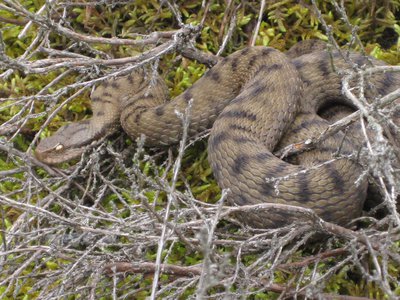
Vipère aspic (CEN Franche-Comté / S.Moncorgé) - CEN Franche-Comté / S.Moncorgé FaunaThe asp viper
Widely present in the marsh area between the Petit Maclu and the Grand Maclu, the asp viper is a poor swimmer and seeks sunny areas to ensure its metabolism can function properly. Like many reptiles, it is fearful and has a talent for detecting vibrations. To avoid bothering this species and being bitten, stamp your feet and be careful not to squash it, it will hide well before you even see it!
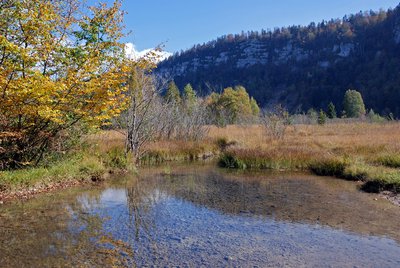
Eentre Maclu et Ilay (OT Haut-Jura Grandvaux / ® B. Leroy ) - OT Haut-Jura Grandvaux / ® B. Leroy Lakes & RiversNatural lakes, a fragile heritage
The waters of the Petit Maclu and the Grand Maclu feed the lake of Ilay. Each occupies a shallow basin dug out by the glaciers around 20,000 years ago.
These lakes are mainly surrounded by a wide diversity of vegetation, called low-marshes, wet tall-herb and fern fringes or peat bogs. Some reed beds also develop there. Insects flourish here due to the high quality of the environment, in particular dragonflies who vary in colour. The Eurasian coot is the most faithful bird to these lakes. Not very discreet, it is recognisable by its trumpeting cries of warning.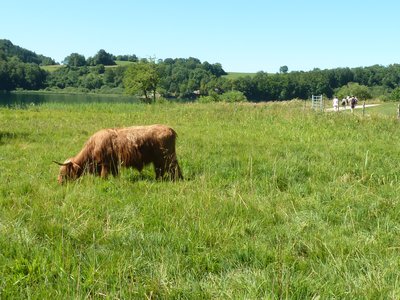
Vache highland cattle (CEN Franche-Comté/ S.Moncorgé) - CEN franche-Comté / S.Moncorgé Natural environmentsA natural managed site
The Franche-Comté conservatory for natural areas manages the wetlands on the 4 lakes site in partnership with the owning municipalities and local farmers. This site is fill of species specific to open environments which must be preserved.
Once used by farmers, these zones have gradually been abandoned. This is why managers have made maintaining this type of environment a priority by reinstating extensive grazing.
Highland Cattle cows are able to move around on waterlogged soil and find the food that they need. The amount of cattle and grazing periods are adapted depending on the species and environments in question.
A site sheet dedicated to the wetlands on the 4 lakes site is available online:
http://cen-franchecomte.org/document.php?iddoc=63DyRcgMw7YQ42PG
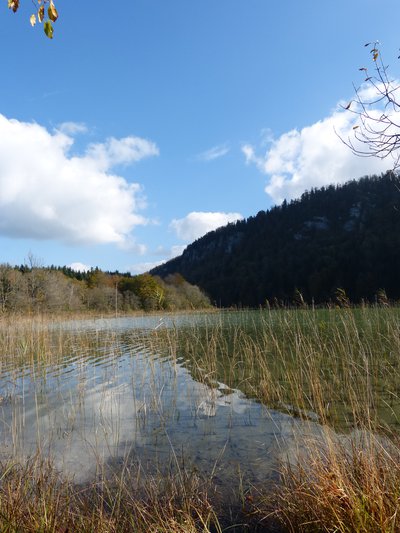
Lac d'Ilay (PNRHJ / Gilles Prost) - PNRHJ / Gilles Prost History & HeritageThe island of La Motte
Centred between the banks of the lake of Ilay is an island: the island of La Motte. Archaeological excavations have revealed that is was home to three successive religious establishments. An initial church was erected around the year 1,000 and seems to have burned down. After being rebuilt, a vestibule was added to it by a monastic congregation that ended up abandoning the place. Of the third establishment, we know only that it was abandoned during the 15th century. A wooden bridge provided access to the structure from the bank and the marshes that are now present were once orchards and pastures.
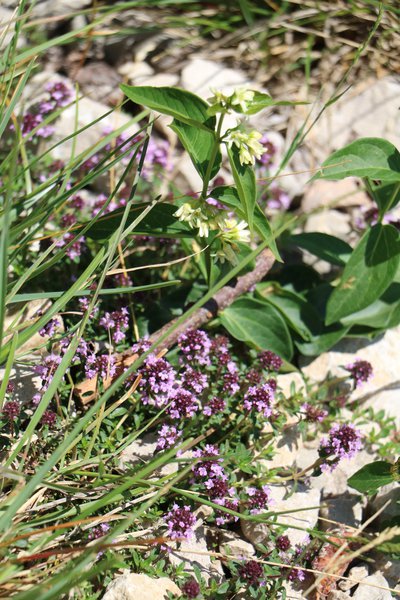
Thym serpolet (CEN Franche-Comté / C.Lapprand) - CEN Franche-Comté / C.Lapprand Natural environmentsDry grasslands
Near lakes, there are not only humid areas!
Where limestone is predominant, water immediately filters through, making life difficult for plants. The soil is not very deep, and is dry and nutrient-poor... These are dry grasslands. Vegetation is neither very tall nor very dense.
The species living in these grasslands adopt special strategies to survive in these difficult living conditions: greasy leaves, parasitism, strong odours, etc. For example, Breckland thyme avoids “sweating” by synthesising essential oils. Its smell is easily recognisable, and this variety of wild thyme is excellent when used to clear airways.
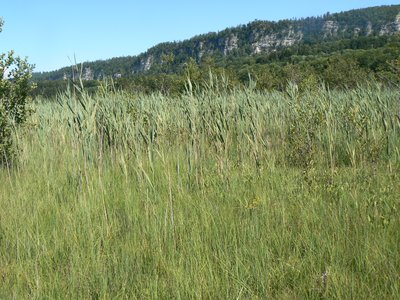
Roseliere (CEN Franche-Comté / L.Bettinelli) - CEN Franche-Comté / L.Bettinelli FloraReed beds
Among the various environments that make up humid areas, reed beds play an essential role: they stabilise the bank and create an area where the plants present filter the water.
It is a safe place and a reproductive area for many species, including birds, such as the Eurasian coot. Throughout the year, their short and powerful cries can be heard here.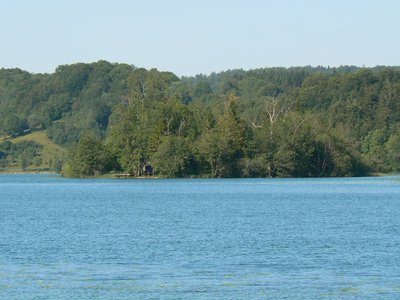
Lac d'Ilay (CEN Franche-Comté / L.Bettinelli) - CEN Franche-Comté / L.Bettinelli Lakes & RiversIlay and drinking water
The Petit Maclu and the Ilay lake provide 10 municipalities with drinking water, including Frasnois. 67,000 cubic meters are used up every year.
The lakes on the Frasnois plateau are natural. The icebergs that covered the Jura 20,000 years ago have “planed” the earth and created the necessary depressions for the lakes to form. The limestone and moraine deposits from the movement of icebergs are watertight and are able to retain the water.
To best preserve the quality of the water, a prefectural order bans the use of thermal engines.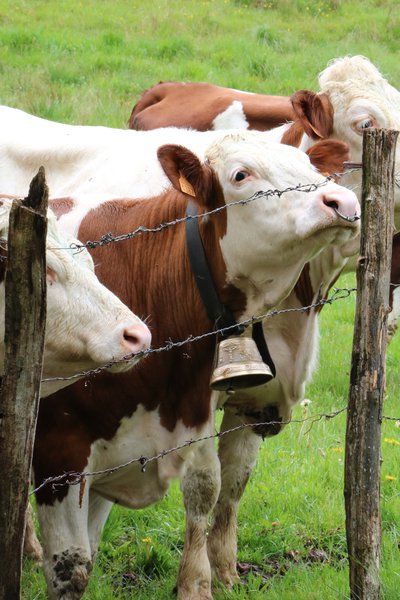
génisses de races Montbéliarde (CEN Franche-Comté / / C.Lapprand) - CEN Franche-Comté / C.Lapprand Pastoralism and agricultureJura landscapes and farming
The Jura massif provides a long geological history. The limestone rocks formed during the Mesozoic era, between -170 million years and -90 million years. Much later, the pushing of the Alpes led these rocks to fold, between -11 million years and -3 million years. Lastly, the erosion caused by the icebergs, the freezing, the water and the wind, have progressively shaped the landscape.
And Man has made the final contribution through farming and development.
Description
From the parking lot, carefully cross the D 75 (yellow waymarking) and head to the Monts des Ifs intersection.
Follow the path to the left below the road and reach the top of the LAC DU PETIT MACLU (Petit Maclu Lake).
Take the good stony path along the lakes, heading past the Petit Maclu and the Grand Maclu, and after a small forest section, arrive at the edge of the Lac d’Ilay before joining up with the Chemin des lacs.
Continue on the path to your right (white and red waymarking) until you reach Lac d’Ilay.
Continue on, following along the right of the D 75 (yellow waymarking), head past a pasture (with barriers to contain the livestock) and locate a grassy path just below the road towards the entrance of the village of Fresnois, at the junction with Chemin des Bornes.
Take the good path to the right, bordered by meadows, for around 350 metres. At the fork, head left and join up with the D 75. Take a path to the right that heads away from the road towards Mont des Ifs.
Carefully cross the road again to return to the Monts des Ifs parking lot.
- Departure : Monts des Ifs parking lot
- Arrival : Monts des Ifs parking lot
- Towns crossed : Le Frasnois and La Chaux-Du-Dombief
Forecast
Sensitive areas
- Impacted practices:
- Aquatic,
- Sensitivity periods:
- JanFebMarAprMayJunJulAugSepOctNovDec
- Contact:
- Parc naturel régional du Haut-Jura
29 Le Village
39310 Lajoux
03 84 34 12 30
www.parc-haut-jura.fr/
- Impacted practices:
- Aerial, Aquatic, Amenities, Underground, Land-based
- Sensitivity periods:
- AprMayJunJulAugSep
- Contact:
- Parc naturel régional du Haut-Jura
29 Le Village
39310 Lajoux
03 84 34 12 30
www.parc-haut-jura.fr/
Recommandations
Be careful when crossing the road at the departure point to reach the Mont des Ifs intersection.
The wetlands around the lakes are preserved and protected natural areas. Please do not leave the waymarked paths and respect the tranquillity of this site.
Cows and horses maintain these areas and are moved from plot to plot throughout the season. These animals are hardy: please do not attempt to approach them or feed them, you could harm their health and put yourself in danger.
Wild flowers are beautiful, they may be rare and protected and often wilt quickly. Do not pick them! They will delight the next hikers.
Please keep your dog on a lead if you have one.
Information desks
Tourist information centre - Haut-Jura Grandvaux
7 place Simone Veil, 39150 Saint-Laurent-en-Grandvaux
Tourist information centre - Jura Monts Rivières
28 rue Baronne Delort, 39300 Champagnole
Tourist information centre - Pays des Lacs et Petite Montagne
36 Grande Rue, 39130 Clairvaux-les-lacs
Transport
To visit and get about in the High-Jura, visit www.reshaut-jura.fr, the eco-mobility portal listing all means of transport within the Park.
Access and parking
14 km from Saint-Laurent-en-Grandvaux via the N 5 towards Champagnole until Pont de la Chaux (municipality of Chaux-des-Crotenay), then take the D 75 towards Frasnois. The Monts des Ifs parking lot is on your right, 500 metres after the Petit Maclu lake parking lot.
Parking :
Report a problem or an error
If you have found an error on this page or if you have noticed any problems during your hike, please report them to us here:
Close by1
Laid-out site
Belvedere of the Pic de l’Aigle (Eagle’s peak)
On the windy top of the Pic de l’Aigle, the landscape is yours to admire. To the west, the two main plateaus that mark the start of the Jura’s relief stretch out before you. The rocky ledge where the Pic de l’Aigle culminates and the lake region mark a break with the relief’s third plateau which is located to the east and gives way to the folded structures of the Jura’s high valleys.

